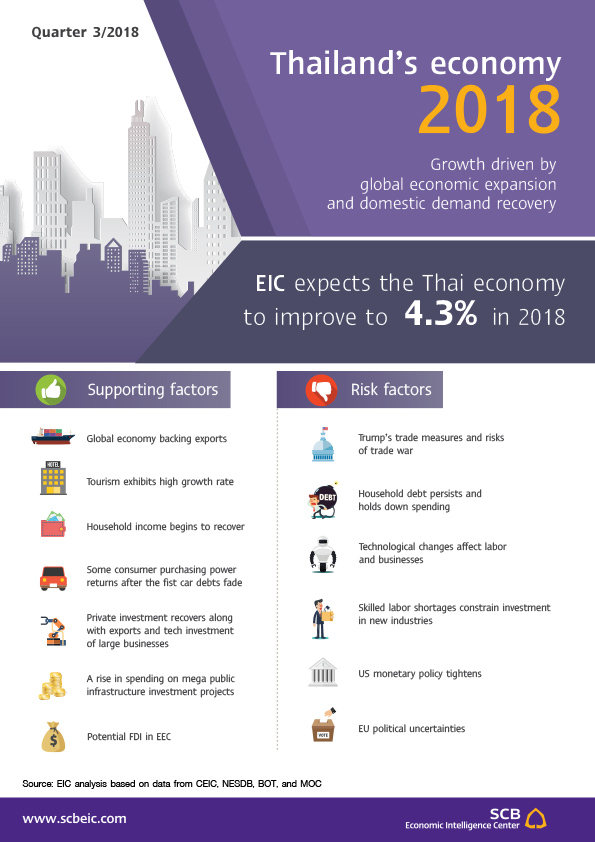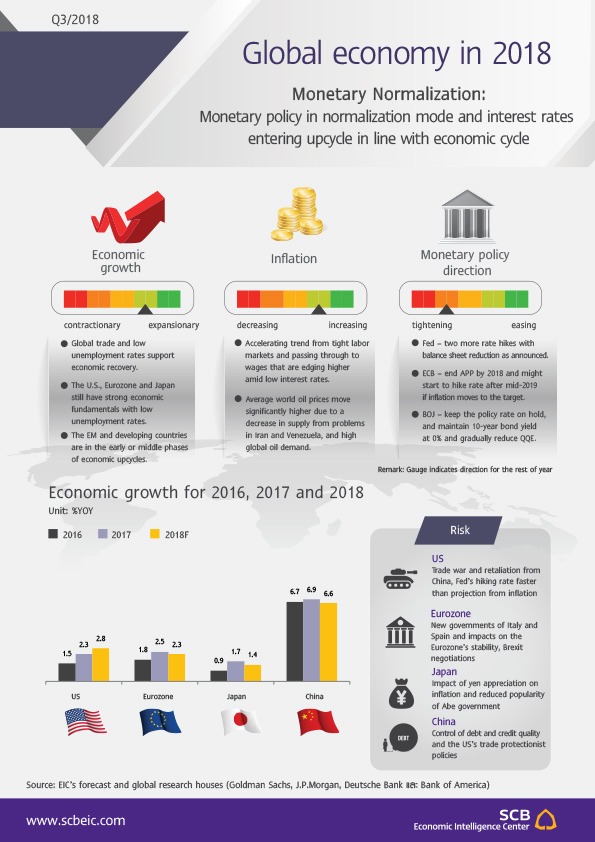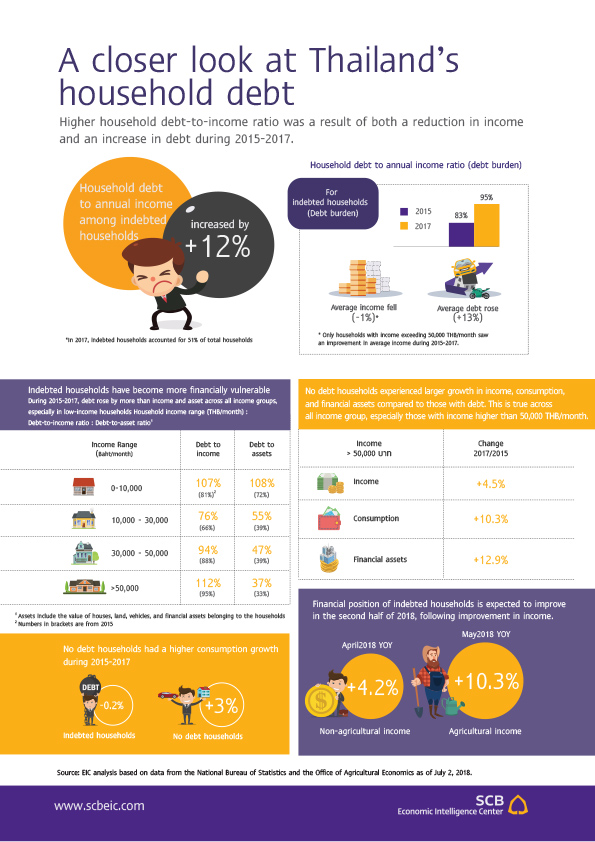Outlook Quarter 3/2018
EIC revised Thailand’s growth forecast for 2018 to 4.3%YOY from the previous forecast of 4.0%YOY, which reflected a stronger growth in recent periods. Thailand’s growth improved in the first half of the year and was more broad-based, driven by external sector from both merchandise exports and tourism which continued to expand at a high rate. This led domestic private demand to begin to recover in conjunction with consumption and investment, while public investment resumed growth after having contracted at the end of the year.

- Thailand economy 2018
- Bull - Bear: Oil Prices
- In focus:
- Box: A close look at global household debt
- Box: The relationship between burden of debt repayment
on income and household consumption
- Summary of main forecasts

EIC revised Thailand’s growth forecast for 2018 to 4.3%YOY from the previous forecast of 4.0%YOY,
which reflected a stronger growth in recent periods. Thailand’s growth improved in the first half of the
year and was more broad-based, driven by external sector from both merchandise exports and tourism
which continued to expand at a high rate. This led domestic private demand to begin to recover in
conjunction with consumption and investment, while public investment resumed growth after having
contracted at the end of the year.
Growth in the latter half of the year faced higher risks than the first half due to the impact of the
trade protectionist measures that were increasingly introduced by the US and the counter measures
by affected countries. EIC assesses that risks to Thailand are quite limited in the short run as only a small
share of Thai export products will be affected. Hence, overall Thai exports in 2018 will likely expand in line
with the global trade. EIC projects that the value of merchandise exports for the whole year will grow
8.5%YOY. However, risks from trade war can possibly worsen, which may affect global trade and Thai
exports in the period ahead. It is therefore increasingly important for exporters to have coping strategies
such as finding new markets or preparing for potentially higher competitions in some markets.
Household income is likely to begin recovering but household debt remains an obstacle. Income
of Thai households tends to recover on the back of farm income which began to expand in the second
quarter after having contracted for 9 consecutive months. Moreover, average wages of workers outside
agricultural sector continued to improve since the beginning of the year, especially in businesses with high
employment in industrial, wholesale and retail, hotel and restaurant sectors. In addition, unemployment
rate also trended down since the beginning of the year. EIC views that household income will likely
continue expanding in the latter half of this year thanks to both domestic and external demand which
are expected to grow and lead to higher demand for labor. However, EIC views that spending growth of
low-income households may take time to recover. This is because household income has just started to
recover after not having increased for a long time, while household debt rose significantly and remains
at a high level. According to survey conducted by National Statistical Office, in 2015-2017 households in all
income groups were observed to have higher debt. Against such backdrop, although household income
will likely improve in 2018, part of the income will be earmarked for debt repayment. As a result, benefits
from rising income will not spilled over to consumption as much as it should.
Thailand’s economic stability remains strong and will provide cushion against volatilities from external
factors. Financial markets’ volatilities increased considerably in recent periods in emerging markets including
Thailand owing to external factors. These included tightening monetary policies of advanced economies,
a stronger US dollar, and concerns on risks of trade war. However, EIC views that due to the Thailand’s
strong economic stability and adequate liquidity in the financial system, risks from such external factors
on the real economy are thus fairly limited.

Global economic outlook 2018
The global economy continues to expand in 2018 with accelerating inflation, led by US growth following
tax reform and strong labor market, together with the Eurozone and Japan growth from their historically
low unemployment rates. The overall global economy will continue expanding, driven by strong economic
fundamentals on the back of international trade and tight labor market conditions across many regions.
In addition to low unemployment, the US economy will benefit from tax cuts for both corporates and
households, and will gain additional momentum from infrastructure investment projects promised by Trump
going forward. Thus, US growth will accelerate at one of the highest rate this year, which will lift inflation
significantly. As for the Eurozone and Japan, although inflation remains low, continued improvement in labor
market conditions and business performance have translated into higher wages. In addition, robust private
consumption will lead to a gradual and stable rise in inflation. Meanwhile, China’s economy, which is likely
to slow down, as well as other emerging economies will still benefit from the growth of major economies
driven by international trade. In addition, commodity price recovery in almost all categories will support
continued growth. Central banks in major economies began tightening their monetary policies, with the Fed
likely increasing its federal funds rate at least three times this year. At the same time, although the ECB
and BOJ still maintain their quantitative easing policy and the asset-purchase program (QE) while keeping
their policy rates on hold, both short-term and long-term interest rates will clearly be on an upward trend
following the end of asset purchases by the ECB this year.
Global economic risks to be monitored going forward will pivot on three key factors: accelerating inflation
and a tighter-than-expected monetary policy, the end of QE measures, and US trade protectionism measures.
The first risk to be considered is that if inflation accelerates too fast or a greater extent than expected,
central banks in many regions, especially in the US, will have to hike policy rates sooner than markets expect.
Hence, overall financing costs will increase from a faster-than-expected rise in both short-term and longterm
interest rates, which will lead to portfolio adjustments and abrupt capital movements in both global
stocks, bonds, and money markets. The second risk concerns a significant decline in the amount of asset
purchases by major central banks as well as the end of QE measures, which should be carefully watched.
This is because the economy and businesses have become accustomed to having excess liquidity for many
years. In particular, there will be less liquidity in the financial sector. There will also be an impact on asset
price stability, which benefited from QE liquidity, particularly in global financial and real estate markets.
These are the sectors to be carefully monitored following the end of QE measures in the future. The last
risk concerns trade protectionism measures that tend to be more severe and targeted on China’s exports
as well as countries with particularly large bilateral trade surpluses with the US. Import tariffs on washing
machines, solar panels, steel, aluminum, and related products, as well as other upcoming measures aimed
at protecting US Manufacturers will cause global economic volatility. This will then affect global confidence,
trade and investment sentiments.

In Focus: A closer look at Thailand’s household debt
One of important structural changes that took place in the Thai economy over the past decade
is the rise in debt-financed household spending. This is reflected in the rapid increase in the
household debt to GDP ratio during 2008-2015, from 51% to 80%. The ratio declined slightly
during 2016-2017, prompting many to believe that the situation has eased, but the latest
analysis of household survey data provides an opposing conclusion. The debt to income ratio
among households with debt across income spectrums did not fall over the last two years.
In fact, it soared as a result of both higher debt and lower incomes, except for high-income
households whose income has increased, yet by less than their debt burden.